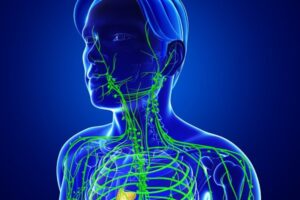
The lymphatic system is a network of channels and glands throughout the body that helps fight infection and remove excess fluid. It drains extra fluid – lymph – that has passed out of the blood and into tissues and returns it back to the blood. Issues with the lymphatic system can lead to oedema – an excess of watery fluid collecting in the body’s tissues or cavities.
Before birth (prenatal)
Abnormalities in development of the lymphatic system can become apparent during pregnancy. The prenatal issues for Noonan Syndrome are:
- Increased nuchal translucency Between 10 and 14 weeks of pregnancy, ultrasound is used to measure the size of the translucent space behind the neck of the foetus – the nuchal translucency. The size reflects the amount of fluid that has accumulated under the skin of the foetus. Nuchal translucency tends to be increased in Noonan syndrome, as well as in other chromosome disorders such as Down syndrome and Turner syndrome.
- Hydrothoraces: Accumulation of fluid in the pleural cavity (the space between the lungs and the walls of the chest) of the foetus.
- Hydrops fetalis: Abnormal fluid collections in the foetus, such as around the heart or lungs, in the abdomen, or in the skin and soft tissues.)
Children and adults
Swelling of the feet at birth is often described in Noonan syndrome, and some of the characteristics of this condition – webbed neck, low-set ears, low hairline and drooping of the upper eyelid (ptosis) – may be related to oedema in the womb.
Persistent lymphatic disorders are rare, however. When they do occur, they can affect:
- Legs: Lymphoedema is a long-term (chronic) condition that causes swelling in the body’s tissues. In Noonan syndrome it usually affects the legs, so is termed bilateral lower limb lymphoedema.
- Genitals: Swollen genitals can be caused by the backflow of chyle (a milky fluid containing fat droplets which drains from the small intestine into the lymphatic system during digestion). If the valves in the lymphatic system do not control the flow correctly, chyle can mix with lymph and be routed into the genitals and legs. This is called chylous reflux.
- Small intestine: Enlarged lymph vessels supplying the lining of the small intestine can lead to a range of problems, including
- Swelling of the legs and abdominal discomfort
- Loss of lymphatic fluid into the intestine
- Leaking of albumin and other protein-rich materials into the intestine (called protein-losing enteropathy)
- Too little albumin in the blood
- Reduced levels of antibodies
- Immunodeficiency (called intestinal lymphangiectasia).
- Chest: Lymphatic fluid can leak into the space between the lung and chest wall. When this fluid builds up in the lungs, it can cause a severe cough, chest pain and difficulty breathing. The condition is termed chylothorax.
The age of onset of these problems varies – for some, swelling begins as a young child, for others as adults.
The causes of these issues in people with Noonan Syndrome are not fully understood. It is not clear whether the primary problem is an abnormality of the valves in the lymphatics and veins, or whether the reflux in the legs and genital region is a result of the chylous reflux from the intestines.
It is also not clear why this may present later in life – the triggers are not known.
Specialist Tests
A technique called lymphoscintigraphy is used to investigate lymphoedema. A radiolabelled tracer is injected, which then allows an image of the lymph drainage pathways to be created using a gamma camera.
Management and treatment
Compression garments and bandaging are used to help reduce swelling of the legs, and a low fat diet or cryotherapy may be effective in reducing swollen genitals.
In 2020, US doctors reported that a Noonan syndrome patient with severe lymphatic issues had been treated successfully with trametinib (an inhibitor of mitogen-activated protein kinase, a component of the Ras/MAPK pathway).

